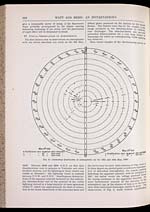Robert Watson-Watt (1892-1973)
An instantaneous direct-reading radiogoniometer
616
WATT AND HERD: AN INSTANTANEOUS
give a measurable sector of swing of the fluorescent
trace, probably accompanied by the elliptic opening
indicating dephasing of one aerial, and the phenomena
of night effect will be delineated in detail.
IV. TYPICAL OBSERVATIONS ON ATMOSPHERICS.
The first decisive test of observations on atmospherics
with the device described was made on the 5th May,
[NLS note: a graphic appears here – see image of page]
FIG. 5. – Azimuthal distribution of atmospherics on the 13th and 14th May, 1925.
1923. Between 2000 and 2300 G.M.T. on that date
thunderstorms were in progress in Yorkshire and other
northern districts, and the lightning of these storms was
visible at Aldershot; this lightning varied in azimuth
between N.N.W. and N.N.E. Simultaneous determina-
tions of the apparent azimuth indicated by the cathode-
ray direction-finder and of the azimuth of the visible
lightning showed in a large majority of cases agreement
within 5°, which was approximately the limit of estima-
tion in the direct observation of the somewhat faint and
diffuse glows produced on the horizon by the distant
flashes. The failures were due to the complex screen
image produced in the direction-finder by relatively
near discharges. The direction-finder also provided
azimuthal determinations for a very large number of
discharges for which no corresponding visible lightning
was observed.
More recent samples of the discriminating power of
the device may be cited, with reference to Figs. 4 and 5.
In these figures are plotted polar co-ordinates representa-
tive of individual atmospherics, the angular position
indicating the apparent azimuth, with its ambiguity of
180°, the radius vector the voltage produced across
the tuning condenser in the apparatus described. No
more fundamental measure of the intensity of the
atmospheric can, in the absence of data as to the wave-
form of the individual discharges, readily be given. The
observations of Fig. 4, made without amplfication,


